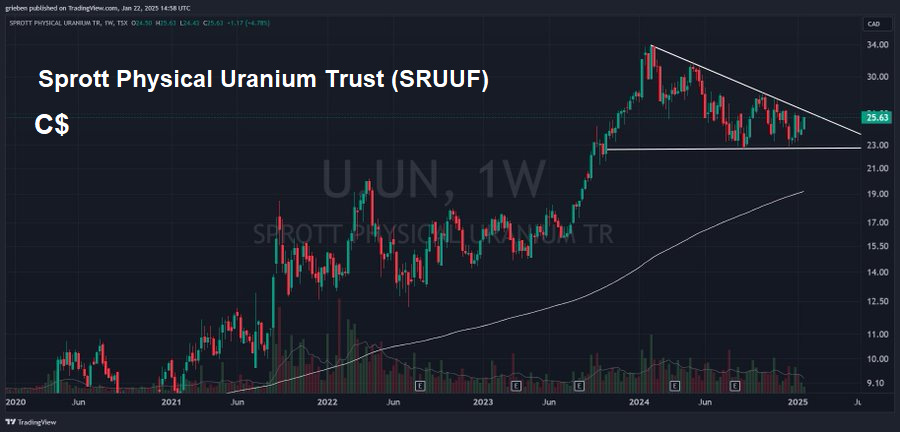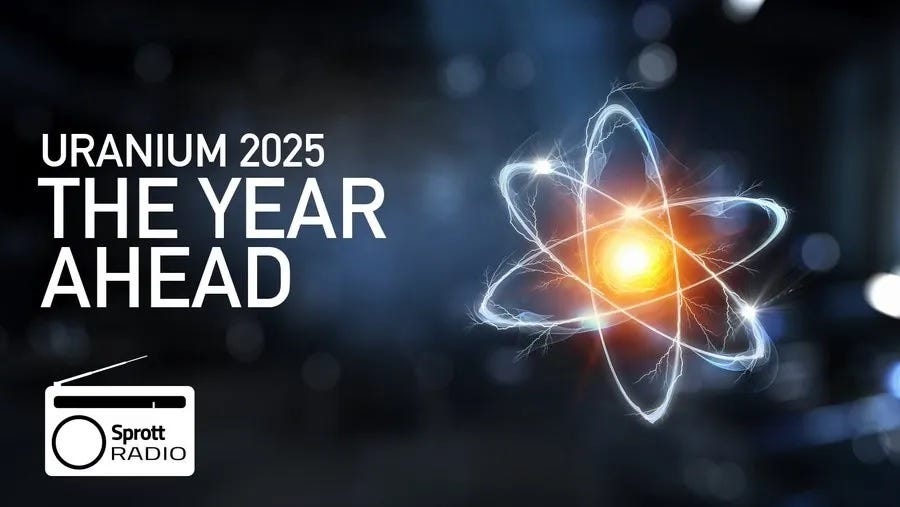After a nice 3-year run, uranium spent 2024 in consolidation mode. Now it looks ready to break out.
Here’s Rick Rule saying good things about uranium’s near-term prospects:
President Trump has made energy a priority, with nuclear firmly in the mix:
Nuclear In Trump’s Day-One Executive Orders
(World Nuclear News) - An executive order on Unleashing American Energy mandates an "immediate review of all agency actions that potentially burden the development of domestic energy resources". It directs the heads of "all agencies" to review existing regulations and agency actions to identify those that "impose an undue burden on the identification, development, or use of domestic energy resources - with particular attention to oil, natural gas, coal, hydropower, biofuels, critical mineral, and nuclear energy resources". It also, among other things, instructs the US Geological Survey "to consider updating the Survey’s list of critical minerals, including for the potential of including uranium".
Then there’s Project Stargate
Trump announces $500B investment in AI infrastructure
(Forbes) - President Trump unveiled a massive artificial intelligence infrastructure project Tuesday, announcing that Softbank, OpenAI and Oracle have joined forces for a project called Stargate, to build data centers in the U.S. for powering AI. Trump says the initial investment for the project will be $100 billion, with plans to expand to $500 billion over the next four years. Trump called it "the largest AI infrastructure project, by far, in history."
Project Stargate Energy Analysis
(Mark Nelson @energybants) - Project Stargate is going to need an enormous amount of power: each of the five Stargates needs about 5 gigawatts (about five million people's worth) of constant electricity for each ~$100b supercomputer project… Nuclear is 4 to 5 years behind where it should be for this exact moment. China can build America's best large reactor design in 5 years, plus a few years before that setting up the power plant location. We have lots of locations more or less ready to roll for these exact reactors. Each Stargate would require 6, or three pairs of 2 GW reactors linked together by transmission lines. If we can get ready to build large reactors straight away, and if the US government supports with loans, we can aim to replace natural gas plants and retire the old coal plants ten years from now with new large reactors.
South Carolina to Reboot Giant Nuclear Project to Meet AI Demand
The artificial-intelligence boom could revive construction of two Santee Cooper reactors. Santee Cooper, the big power provider in South Carolina, has tapped financial advisers to look for buyers that can restart construction on a pair of nuclear reactors that were mothballed years ago.
The state-owned utility is betting interest will be strong, with tech giants such as Amazon.com and Microsoft in need of clean energy to fuel data centers for artificial-intelligence capabilities.
Saudi Arabia announces plans to enrich and sell uranium
Saudi Arabia plans to begin enriching and selling uranium, according to the Ministry of Energy.
Energy Minister Prince Abdulaziz bin Salman Al Saud told a conference in Dhahran on Monday that the move is part of a strategy to monetise all minerals, according to Reuters news agency.
“We will enrich it and we will sell it and we will do a ‘yellowcake’,” he said, referring to a powdered concentrate used to prepare uranium fuel for nuclear reactors. It requires safe handling although it poses few radiation risks.
Saudi Arabia is developing a fledgling nuclear programme and has plans to expand it to include uranium enrichment – a sensitive issue due to its potential link to nuclear weapons. Riyadh insists it aims to use nuclear power to diversify its energy mix.
And here’s a tiny excerpt from Sprott’s much longer Uranium 2025 podcast:
There’s certainly no shortage of things that will factor into the #uranium market in 2025. A new U.S. administration, nuclear-powered #AI data centers and challenging geopolitics, to name but a few. Per Jander and John Ciampaglia join host Ed Coyne to break it down and share their insights.
Podcast Transcript
John Ciampaglia: The most positive thing we can share with the audience is the profound institutional interest in all things nuclear energy over the last six months or so. I think it's on the back of continuing acknowledgment and realization that nuclear energy needs to be part of the energy mix. Then, more recently, the number of big tech announcements that we've had between nuclear energy companies, existing ones, and startups developing next-generation reactors, I think has really highlighted and broadened tremendous awareness to people.
I think it's fair to say that nuclear is now included as part of this AI ecosystem. Like copper was earlier in the year, people are starting to connect the dots and trying to figure out all the key parts of this ecosystem to make this AI race happen. Energy is the one piece that everyone is now focused on. It's not the code; it's not the chips, it's not the data center; it's the electricity that I think big tech companies have validated this technology by signing these long-term agreements, whether it's restarting Three Mile Island or some of the equity investments they're making in some of these startup technology companies.
Per Jander: The Western world will have to come up with its own uranium supply. They will be looking at Canada. They will be looking at Australia. Africa is a very interesting playground where it's going to go both sides. It can go to the West, but China and Russia are already in there in Niger on the ground and trying to fill the vacuum left by the French. We're going to have to look at the U.S. as well on some of their domestic production there.
The big tech entrance into the market is unlike anything I've ever seen. I've been in the nuclear industry for 20 years. The negative side is that I'm set in my ways, and things take time and patience, but these guys don't have that mindset. They say, "Hey, this is a problem we must solve." They're extremely capable. Their resources are on a level I've never seen before. I'm very, very excited about that.
Read or listen to the rest here.





